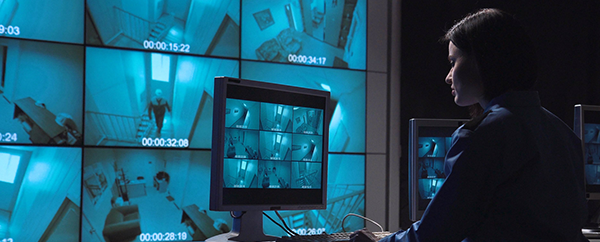View what’s trending in electronic security
Most often, electronic security trends are driven by the latest vulnerabilities. But technological innovations are bringing welcome opportunities and more complex challenges than ever before. Keeping pace with the changes and their implications – for vendors, customers and regulators – demands focus and forward thinking.
If you offer electronic security and alarm coverage to insurance clients such as installers or monitoring companies, this blogpost will keep you in the loop for the latest electronic security trends that your clients are using (or soon will be).
View our Electronic Security & Alarm Program here.
1. Using generative AI and machine learning
Of our five electronic security trends, AI is far and away the most impactful. Significant potential for AI and machine learning is primarily focused on advanced analytics on the edge of the network, in cameras themselves. AI technologies can detect both network traffic and data irregularities. They can also monitor user behaviors for any suspicious activity whether it’s a physical security or a cyber risk.
The industry has already experienced great strides in the accuracy and reliability of video cameras equipped with AI analytics. No longer does an operator need to watch live video. Instead, electronic systems are able to accurately detect and identify people, detect weapons, classify vehicles and objects, as well as pinpoint their locations and enable faster forensic searches, says an Avigilon article.
“Virtually any new network camera being launched features deep learning capabilities, which vastly improve the accuracy of analytics,” says an Axis blogpost. “These capabilities are the foundation for building scalable cloud solutions as they remove such heavy bandwidth requirements, reduce processing in the cloud, and make the system more reliable.”
This year we should see more security-focused applications using large language models (LLMs) and generative AI. Axis opines that these will assist operators, helping them more accurately and efficiently interpret what’s happening in a scene, and as interactive customer support, providing more useful and actionable responses to queries from customers. AI’s insights can help drive revenue and cut inefficiencies through heat maps, people/vehicle counting and combing through activity logs.
At the same time, we must be aware of the risks of generative AI. Camera networks are prime targets for malicious hackers, so businesses must take steps to protect their infrastructure, including encryption, installing the latest software updates and following cybersecurity best practices.
Avigilon warns, “Businesses should not become over-dependent on AI and machine learning to manage their security operations. Human input is still critical to safeguarding valuable assets and people, so security teams must find a balance between the use of AI and machine learning without removing the valuable involvement of a security operator.”
2. Cloud-based surveillance solutions
Recent electronic security trends involving cloud computing are working to integrate technology solutions and streamline multi-site management, thus enabling fully remote security operations.
As a result, says Avigilon, “Businesses and security teams can access, manage and control their security operations from anywhere at any time. No longer are security operators restricted to monitoring events across their facilities from behind their desks. Teams can carry out their daily duties and monitor on-site activities remotely via video cameras, such as IP dome cameras, and on the go via browsers or mobile devices.”
However, cloud security is not without risks. Companies that rely heavily on cloud storage for their security technologies and devices must strengthen their security measures to protect against data loss and hacking threats. To ensure a business’s information is secure, measures such as intrusion detection systems, door access control systems and advanced data encryption should be considered.
3. Regulation and compliance driving electronic security trends
The regulatory environment is increasing its impact on technology development and application. In fact, it’s never been more important to be aware of security’s legal and ethical consequences. From the placement of a camera to the management of data and facial recognition, regulations are becoming more stringent.
AI, cybersecurity, sustainability, corporate governance – all are areas coming under greater regulatory scrutiny. Insurance agents, your security industry clients need to develop their own technologies and operate their own businesses in ways that support their customers’ compliance requirements.
4. Adding safety to security
With our climate change’s extreme weather conditions causing tornadoes, hurricanes, floods, wildfires and more, companies will look to video surveillance, environmental sensors and analytics to act quickly to minimize damage.
Companies’ focus on risk management and regulatory requirements is another key growth area for electronic security. Video surveillance is being used extensively to ensure adherence to safe working practices, such as lockout/tagout procedures and wearing required Personal Protective Equipment (PPE). When incidents do take place, video surveillance is an increasingly important investigation tool.
5. Using hybrid architecture to unify security systems
Hybrid solution architectures, defined by Axis as those employing the advantages of on-premise, cloud and edge technologies, have become the new standard. Resulting in greater flexibility and efficiency, this ecosystem of technologies allows for the optimum functionalities to be deployed. It may also allow vendors better control in managing elements of the system, reducing the burden on customers.
Unifying these technologies, such as “integrating radio with video security and access control, can result in more efficient operations, higher productivity and faster response times to developing threats and incidents,” says Avigilon. “By removing these siloes and bringing them together on a single platform, security teams can simplify management and automate workflows. For example, instead of installing an access reader, a security camera and an intercom device at the front door, all-in-one video door intercom systems now combine all these functions into a single device.”
Further advancements in technology this year will bring further challenges for us all to navigate. These five electronic security trends are only the tip of the iceberg. As ever, we’re looking forward to working with our producers and their clients to continue to grow with the industry.
Ready to contract with us to offer Arrowhead Security & Alarm Program to your clients? Start here.

